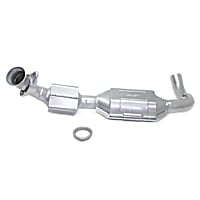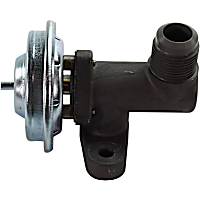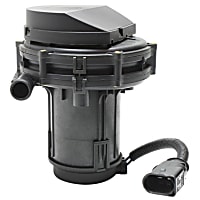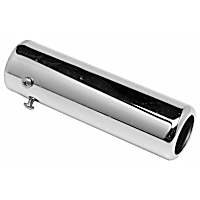The need to control the emissions from automobiles gave rise to the computerization of the automobile. Hydrocarbons, carbon monoxide and oxides of nitrogen are created during the combustion process and are emitted into the atmosphere from the tail pipe. There are also hydrocarbons emitted as a result of vaporization of gasoline and from the crankcase of the automobile. The clean air act of 1977 set limits as to the amount of each of these pollutants that could be emitted from an automobile. The manufacturers answer was the addition of certain pollution control devices and the creation of a self adjusting engine. 1981 saw the first of these self adjusting engines. They were called feedback fuel control systems. An oxygen sensor was installed in the exhaust system and would measure the fuel content of the exhaust stream. It then would send a signal to a microprocessor, which would analyze the reading and operate a fuel mixture or air mixture device to create the proper air/fuel ratio. As computer systems progressed, they were able to adjust ignition spark timing as well as operate the other emission controls that were installed on the vehicle. The computer is also capable of monitoring and diagnosing itself. If a fault is seen, the computer will alert the vehicle operator by illuminating a malfunction indicator lamp. The computer will at the same time record the fault in it’s memory, so that a technician can at a later date retrieve that fault in the form of a code which will help them determine the proper repair. Some of the more popular emission control devices installed on the automobile are: EGR VALVE, CATALYTIC CONVERTER, AIR PUMP, PCV VALVE, CHARCOAL CANISTER.
Catalytic Converter

Automotive emissions are controlled in three ways, one is to promote more complete combustion so that there are less by products. The second is to reintroduce excessive hydrocarbons back into the engine for combustion and the third is to provide an additional area for oxidation or combustion to occur. This additional area is called a catalytic converter. The catalytic converter looks like a muffler. It is located in the exhaust system ahead of the muffler. Inside the converter are pellets or a honeycomb made of platinum or palladium. The platinum or palladium are used as a catalyst ( a catalyst is a substance used to speed up a chemical process). As hydrocarbons or carbon monoxide in the exhaust are passed over the catalyst, it is chemically oxidized or converted to carbon dioxide and water. As the converter works to clean the exhaust, it develops heat. The dirtier the exhaust, the harder the converter works and the more heat that is developed. In some cases the converter can be seen to glow from excessive heat. If the converter works this hard to clean a dirty exhaust it will destroy itself. Also leaded fuel will put a coating on the platinum or palladium and render the converter ineffective. This is why, in the U.S.A., all fuels designed for automobile engines are now unleaded.
PCV Valve
The purpose of the positive crankcase ventilation (PCV) system, is to take the vapors produced in the crankcase during the normal combustion process, and redirecting them into the air/fuel intake system to be burned during combustion. These vapors dilute the air/fuel mixture so they have to be carefully controlled and metered in order to not affect the performance of the engine. This is the job of the positive crankcase ventilation (PCV) valve. At idle, when the air/fuel mixture is very critical, just a little of the vapors are allowed in to the intake system. At high speed when the mixture is less critical and the pressures in the engine are greater, more of the vapors are allowed in to the intake system. When the valve or the system is clogged, vapors will back up into the air filter housing or at worst, the excess pressure will push past seals and create engine oil leaks. If the wrong valve is used or the system has air leaks, the engine will idle rough, or at worst, engine oil will be sucked out of the engine.

EGR Valve
The purpose of the exhaust gas recirculation valve (EGR) valve is to meter a small amount of exhaust gas into the intake system, this dilutes the air/fuel mixture so as to lower the combustion chamber temperature. Excessive combustion chamber temperature creates oxides of nitrogen, which is a major pollutant. While the EGR valve is the most effective method of controlling oxides of nitrogen, in it’s very design it adversely affects engine performance. The engine was not designed to run on exhaust gas. For this reason the amount of exhaust entering the intake system has to be carefully monitored and controlled. This is accomplished through a series of electrical and vacuum switches and the vehicle computer. Since EGR action reduces performance by diluting the air /fuel mixture, the system does not allow EGR action when the engine is cold or when the engine needs full power.
Evaporative Controls
Gasoline evaporates quite easily. In the past, these evaporative emissions were vented into the atmosphere. 20% of all HC emissions from the automobile are from the gas tank. In 1970 legislation was passed, prohibiting venting of gas tank fumes into the atmosphere. An evaporative control system was developed to eliminate this source of pollution. The function of the fuel evaporative control system is to trap and store evaporative emissions from the gas tank and carburetor. A charcoal canister is used to trap the fuel vapors. The fuel vapors adhere to the charcoal, until the engine is started, and engine vacuum can be used to draw the vapors into the engine, so that they can be burned along with the fuel/air mixture. This system requires the use of a sealed gas tank filler cap. This cap is so important to the operation of the system, that a test of the cap is now being integrated into many state emission inspection programs. Pre-1970 cars released fuel vapors into the atmosphere through the use of a vented gas cap. Today with the use of sealed caps, redesigned gas tanks are used. The tank has to have the space for the vapors to collect so that they can then be vented to the charcoal canister. A purge valve is used to control the vapor flow into the engine. The purge valve is operated by engine vacuum. One common problem with this system is that the purge valve goes bad and engine vacuum draws fuel directly into the intake system. This enriches the fuel mixture and will foul the spark plugs. Most charcoal canisters have a filter that should be replaced periodically. This system should be checked when fuel mileage drops.
Air Injection
Since no internal combustion engine is 100% efficient, there will always be some unburned fuel in the exhaust. This increases hydrocarbon emissions. To eliminate this source of emissions an air injection system was created. Combustion requires fuel, oxygen and heat. Without any one of the three, combustion cannot occur. Inside the exhaust manifold there is sufficient heat to support combustion, if we introduce some oxygen than any unburned fuel will ignite. This combustion will not produce any power, but it will reduce excessive hydrocarbon emissions. Unlike in the combustion chamber, this combustion is uncontrolled, so if the fuel content of the exhaust is excessive, explosions, that sound like popping, will occur. There are times when under normal conditions, such as deceleration, when the fuel content is excessive. Under these conditions we would want to shut off the air injection system. This is accomplished through the use of a diverter valve, which instead of shutting the air pump off, diverts the air away from the exhaust manifold. Since all of this is done after the combustion process is complete, this is one emission control that has no effect on engine performance. The only maintenance that is required is a careful inspection of the air pump drive belt.
How to Get Quality Replacement Parts For Your Emission Control Systems
Any issues in your emission control systems can easily lead to increased emissions, which can impact your health and safety. That’s why if any of the parts in your emission control systems are faulty, it’s best to have them repaired or replaced. Fortunately, you can order new parts from the comfort of your own home at CarParts.com.
CarParts.com has a host of different parts, all for sale on our easy-to-navigate website. If you use our built-in vehicle selector, we can even guarantee the parts will fit your vehicle’s emission control systems perfectly. Our fast shipping means you’ll receive your parts in as fast as two business days. Should you encounter any issues or have any questions, feel free to reach out to our helpful and friendly customer service team who will be happy to help you around the clock.
Order a new catalytic converter or other parts for your emission control systems today only at CarParts.com.
Products Mentioned in this Guide
Any information provided on this Website is for informational purposes only and is not intended to replace consultation with a professional mechanic. The accuracy and timeliness of the information may change from the time of publication.


 Catalytic Converter
Catalytic Converter
 EGR Valve
EGR Valve
 PCV Valve
PCV Valve
 Oxygen Sensor
Oxygen Sensor
 Air Pump
Air Pump
 Tail Pipe
Tail Pipe















I was pulling a 5th wheel trailer and then I lost power could only go 5mph stopped reset engine light then made it back home, it seems to work fine without a load on when check engine light is on.
I have a 2010 f350 and my check engine light came on, checked and have a p2080 code i would like to know where I should start to find out how to fixit?
The code indicates you need to replace your EGT sensor on your exhaust. Bank 1 sensor 1 if you are not sure what the bank or sensor 1 means just look up the exhaust system on your vehicle and also ask about the banks and sensors when researching. It’s a simple sensor to change. Hope that helps.
How to perform service on a P0410 code for a 2010 Mercedes Benz ML350 4 matic?
Hello Levi,
Code P0401 points to a problem with the secondary air injection. The root cause of the code could be anything from a faulty air injection pump to a faulty relay. You (or your mechanic) will need to do some troubleshooting for a definitive answer. Good luck!
Can anyone help me connect or have a diagram of the vacuum hoses and can I plug some of the hoses